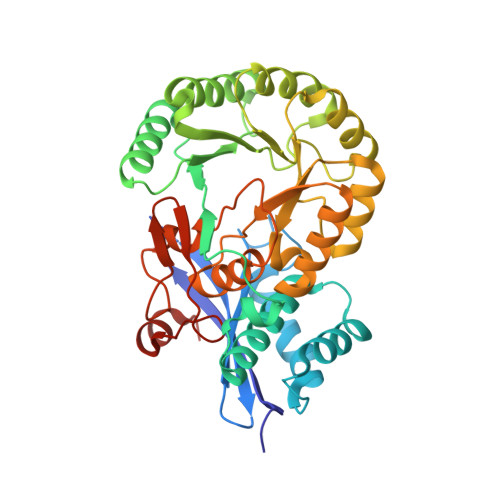Evolution of enzymatic activities in the enolase superfamily: stereochemically distinct mechanisms in two families of cis,cis-muconate lactonizing enzymes.
Sakai, A., Fedorov, A.A., Fedorov, E.V., Schnoes, A.M., Glasner, M.E., Brown, S., Rutter, M.E., Bain, K., Chang, S., Gheyi, T., Sauder, J.M., Burley, S.K., Babbitt, P.C., Almo, S.C., Gerlt, J.A.(2009) Biochemistry 48: 1445-1453
- PubMed: 19220063
- DOI: https://doi.org/10.1021/bi802277h
- Primary Citation of Related Structures:
3CT2, 3DG3, 3DG6, 3DG7, 3DGB, 3FJ4 - PubMed Abstract:
The mechanistically diverse enolase superfamily is a paradigm for elucidating Nature's strategies for divergent evolution of enzyme function. Each of the different reactions catalyzed by members of the superfamily is initiated by abstraction of the alpha-proton of a carboxylate substrate that is coordinated to an essential Mg(2+). The muconate lactonizing enzyme (MLE) from Pseudomonas putida, a member of a family that catalyzes the syn-cycloisomerization of cis,cis-muconate to (4S)-muconolactone in the beta-ketoadipate pathway, has provided critical insights into the structural bases for evolution of function within the superfamily. A second, divergent family of homologous MLEs that catalyzes anti-cycloisomerization has been identified. Structures of members of both families liganded with the common (4S)-muconolactone product (syn, Pseudomonas fluorescens, gi 70731221 ; anti, Mycobacterium smegmatis, gi 118470554 ) document that the conserved Lys at the end of the second beta-strand in the (beta/alpha)(7)beta-barrel domain serves as the acid catalyst in both reactions. The different stereochemical courses (syn and anti) result from different structural strategies for determining substrate specificity: although the distal carboxylate group of the cis,cis-muconate substrate attacks the same face of the proximal double bond, opposite faces of the resulting enolate anion intermediate are presented to the conserved Lys acid catalyst. The discovery of two families of homologous, but stereochemically distinct, MLEs likely provides an example of "pseudoconvergent" evolution of the same function from different homologous progenitors within the enolase superfamily, in which different spatial arrangements of active site functional groups and substrate specificity determinants support catalysis of the same reaction.
- Center for Biophysics and Computational Biology, University of Illinois, Urbana, Illinois 61801, USA.
Organizational Affiliation:

















